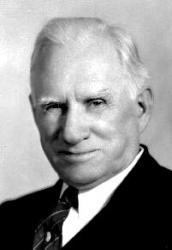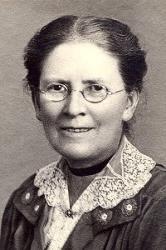Planning worship?
Check out our sister site, ZeteoSearch.org,
for 20+ additional resources related to your search.
- |
User Links
Person Results
Johnson Oatman, Jr.

1856 - 1922 Person Name: Rev. Johnson Oatman, Jr. Author of "Press Along" in Hymns We Love, for Sunday Schools and All Devotional Meetings Johnson Oatman, Jr., son of Johnson and Rachel Ann Oatman, was born near Medford, N. J., April 21, 1856. His father was an excellent singer, and it always delighted the son to sit by his side and hear him sing the songs of the church.
Outside of the usual time spent in the public schools, Mr. Oatman received his education at Herbert's Academy, Princetown, N. J., and the New Jersey Collegiate Institute, Bordentown, N. J. At the age of nineteen he joined the M.E. Church, and a few years later he was granted a license to preach the Gospel, and still later he was regularly ordained by Bishop Merrill. However, Mr. Oatman only serves as a local preacher.
For many years he was engaged with his father in the mercantile business at Lumberton, N. J., under the firm name of Johnson Oatman & Son. Since the death of his father, he has for the past fifteen years been in the life insurance business, having charge of the business of one of the great companies in Mt. Holly, N. J., where he resides.
He has written over three thousand hymns, and no gospel song book is considered as being complete unless it contains some of his hymns.
In 1878 he married Wilhelmina Reid, of Lumberton, N.J. and had three children, Rachel, Miriam, and Percy.
Excerpted from Biography of Gospel Song and Hymn Writers by Jacob Henry Hall; Fleming H. Revell, Co. 1914
Johnson Oatman, Jr.
Kate Taylor
Author of "I have a Little Time, 't ain't very Long" in A Collection of Revival Hymns and Plantation Melodies
Kate Taylor
William R. Newell

1868 - 1956 Person Name: W. R. Newell Composer of "[Oft I hear a gentle whisper o'er me stealing]" in Light and Life Songs No. 3 William Newell (1868-1956) was born in Savannah, OH. He earned degrees from Wooster College, Princeton and Oberlin Theological Seminary. He served as Assistant Superintendent of the Moody Bible Institute, Chicago. The words for his hymn "At Calvary" came to him on his way to teach a class at the Bible Institute. He slipped into an empty classroom and wrote them quickly on the back of an envelope. (see bio in 101 More Hymn Stories, Osbeck, Grand Rapids, MI: Kregel, 1985.)
Mary Louise VanDyke
William R. Newell
Daniel Otis Teasley

1876 - 1942 Person Name: D. O. T. Author of "Ye Reapers of the Cross" in Songs of Grace and Glory Daniel Otis Teasley, 1876-1942
Died: November 15, 1942, Santa Ana, California.
Teasley entered the ministry of the Church of God denomination in 1896, and pastored in New York. Sometime after 1910, he became General Manager of the Gospel Trumpet Company, where he worked until 1917. He then worked as general manager of Warner Press (1917-18). His works include:
Historical Geography of the Bible, 1898, 1917
The Holy Spirit and Other Spirits, 1904
How to Conduct a Sunday School, 1911
The Gospel Guide-book, 1918
The Bible and How to Interpret It, 1918
Lyrics--
At the Cross of Jesus Bowing
Back to the Blessèd Old Bible
Be Ready When He Comes
I Am the Lord’s
I Know in My Heart What It Means
I Will Praise Him, Hallelujah!
In Holy Reverence, Lord
Song of Joy, A
We’ll Crown Him Lord of All
We’ll Praise the Lord
Music--
No Friend Like Jesus
Reverena
--hymntime.com/tch/
Daniel Otis Teasley
William Williams

1717 - 1791 Person Name: William Williams, 1717-1791 Author of "Great Redeemer, Friend Of Sinners" in The Cyber Hymnal William Williams, called the "Watts of Wales," was born in 1717, at Cefn-y-coed, near Llandovery, Carmarthenshire. He originally studied medicine, but abandoned it for theology. He was ordained Deacon in the Church of England, but was refused Priest's Orders, and subsequently attached himself to the Calvinistic Methodists. For half a century he travelled in Wales, preaching the Gospel. He died in 1791. Williams composed his hymns chiefly in the Welsh language; they are still largely used by various religious bodies in the principality. Many of his hymns have appeared in English, and have been collected and published by Sedgwick. His two principal poetical works are "Hosannah to the Son of David," and "Gloria in Excelsis."
--Annotations of the Hymnal, Charles Hutchins, M.A. 1872.
=====================
Williams, William, of Pantycelyn, was the Sweet Singer of Wales. He was born at Cefn-y-Coed, in the Parish of Llanfair-y-bryn, near Llandovery, in 1717. He was ordained a deacon of the Established Church in 1740, by Dr. Claget, Bishop of St. Davids, and for three years he served the Curacies of Llan-wrtyd and Llanddewi-Abergwesyn. He never received Priest's Orders. He became early acquainted with the revivalist Daniel Rowlands, and for thirty-five years he preached once a month at Llanllian and Caio and Llansawel, besides the preaching journeys he took in North and South Wales. He was held in great esteem as a preacher. In 1744 his first book of hymns appeared under the title of Halleluiah, and soon ran through three editions. In1762, he published another book under the title of Y Môr o Wydr, which soon went through five editions. His son John published an excellent edition of his hymns in the year 181lines In addition to his Welsh hymns Williams also published several in English as:—
(1.) Hosannah to the Son of David; or, Hymns of Praise to God, For our glorious Redemption by Christ. Some few translated from the Welsh Hymn-Book, but mostly composed on new Subjects. By William Williams. Bristol: Printed by John Grabham, in Narrow-Wine Street, 1759. This contains 51 hymns of which 11 are translated from his Welsh hymns. This little book was reprinted by D. Sedgwick in 1859.
(2.) Gloria in Excelsis: or, Hymns of Praise to God and the Lamb. By W. Williams . . . Carmarthen. Printed for the Author by John Ross, removed to Priory Street, near the Church, M.DCC.LXXI. This contains 70 hymns, not including parts.
From these volumes the following hymns are in common use:—
i. From the Hosannah, 1759:—
1. Jesus, my Saviour is enough. Jesus, All in All.
2. My God, my God, Who art my all. Communion with God desired.
3. The enormous load of human guilt. God's love unspeakable.
ii. From the Gloria in Excelsis, 1772.
4. Awake, my soul, and rise. Passiontide.
5. Beneath Thy Cross I lay me down. Passiontide.
6. Hark! the voice of my Beloved. The Voice of Jesus.
7. Jesus, lead us with Thy power. Divine Guidance Desired. Sometimes given as "Father, lead us with Thy power."
8. Jesus, Whose Almighty sceptre. Jesus as King.
9. Saviour, look on Thy beloved. The Help of Jesus desired.
10. White and ruddy is my Beloved. Beauties of Jesus.
Williams is most widely known through his two hymns, "Guide me, O Thou great Jehovah," and "O'er those gloomy hills of darkness." Williams died at Pantycelyn, Jan. 11, 1791. [Rev. W. Glanffrwd Thomas]
-- John Julian, Dictionary of Hymnology (1907)
=================
See also in:
Hymn Writers of the Church
William Williams
Queen Liliuokalani

1838 - 1917 Person Name: Liliuokalani Composer of "[Beyond the pale of earthly blight]" in Great Tabernacle Hymns
Queen Liliuokalani
R. Martin Pope

1865 - 1944 Translator of "Hymn for Those Who Fast" in Hymns of Prudentius Pope, Robert Martin, M.A., s. of Rev. H. J. Pope, D.D. (ex-President of the Wesleyan Conference), was born in London, Jan. 4, 1865, and was educated at Manchester Grammar School, Victoria Univ., Manchester, and St. John's Coll., Cambridge (B.A. 1887, M.A. 1896). He entered the Wesleyan Ministry in 1888 and is now (1906) stationed at Oxford. He was joint author of The Hymns of Prudentius, translated by R. Martin Pope and R. F. Davis, 1905, being a verse translation of the Cathemerinon of Prudentius with notes. Two of Mr. Pope's versions are in The English Hymnal, 1906, Nos. 54, 55. He also contributed articles on Latin Hymnody, with some original translations, to the London Quarterly Review, July 1905 and Jan. 1906, with a supplemental note in July 1906 containing two translations into Latin verse. [Rev. James Mearns, M.A.]
--John Julian, Dictionary of Hymnology, New Supplement (1907)
R. Martin Pope
John Roberts
1822 - 1877 Person Name: John Roberts, 1823-1877 Composer of "ALEXANDER" in The Cyber Hymnal Used Ieuan Gwyllt as his bardic name. See also Ieuan Gwyllt, 1822-1877.
John Roberts


 My Starred Hymns
My Starred Hymns



